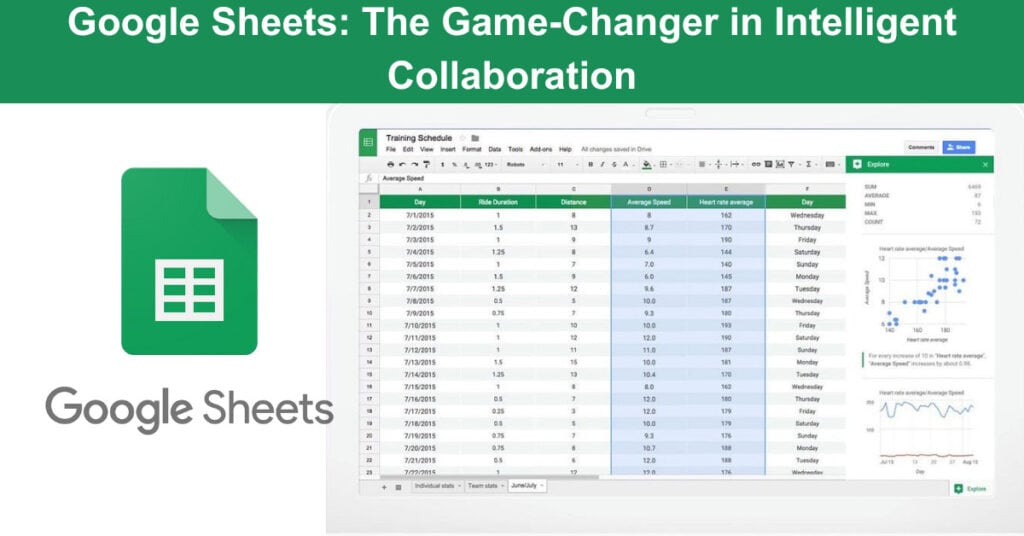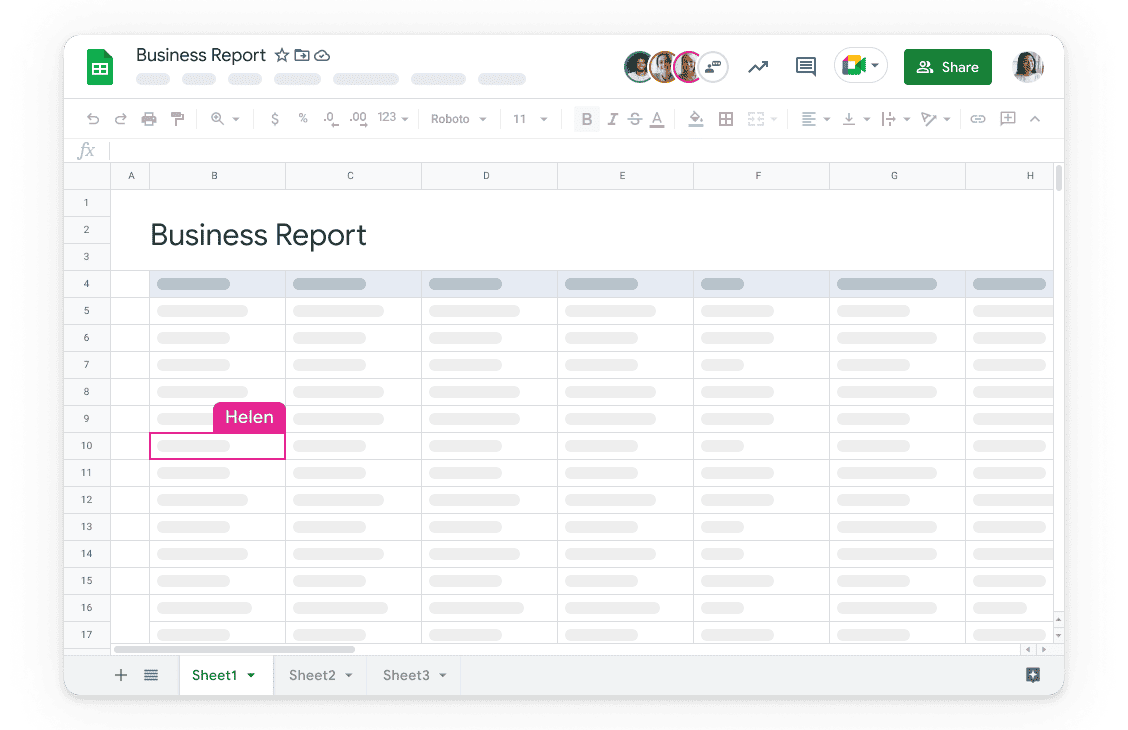
Spreadsheet software has moved far beyond static tables of numbers. Google Sheets has evolved into an intelligent, AI-powered platform that redefines how teams manage data, collaborate in real-time, and derive actionable insights. By integrating advanced AI through Gemini, connecting to enterprise data warehouses, and enhancing its core collaborative DNA, Google Sheets is no longer just an alternative to desktop software—it is the central hub for dynamic data work in the modern, connected workspace.
This article explores Google Sheets‘ transformative features, from AI-assisted analysis to robust security, proving its indispensable role for businesses of all sizes.
AI-Powered Intelligence in Google Sheets
The most significant leap forward for Google Sheets is the deep integration of generative AI via Gemini. This transforms it from a reactive tool into an active collaborator that can understand context, generate complex formulas, and uncover hidden patterns. Users can now instruct Sheets in natural language to build trackers, create data visualizations, and analyze trends, dramatically lowering the technical barrier to sophisticated data management and empowering every team member to become more data-proficient.
- Gemini-Assisted Creation: Use simple prompts to generate entire spreadsheets, tables, or business templates tailored to specific needs like revenue tracking or project management.
- Intelligent Formula Generation: Describe the calculation you need in plain language, and Gemini will write the correct, ready-to-use formula (e.g.,
SUMIFS,XLOOKUP), eliminating the need to memorize syntax. - Smart Data Analysis: Ask Gemini to identify trends, outliers, or correlations within your dataset to quickly generate summaries and insights without manual chart building.
- Smart Fill & Cleanup: Automatically format data into structured tables and use “@” mentions to insert smart chips for people, files, and dates, keeping data organized and actionable.
Google Sheets Unparalleled Collaboration in Real-Time

Real-time co-editing remains the cornerstone of Google Sheets, but it has been enhanced with richer, context-aware features. Teams can now collaborate not just on data entry, but on analysis and decision-making within the document itself. The integration of Meet directly within a sheet and sophisticated comment threads turns the spreadsheet into a dynamic meeting room and project hub, collapsing the distance between discussion and execution.
- Live Co-Editing & Presence: See collaborators’ cursors and selections in real-time, with all changes saved automatically to version history, eliminating conflicts and version confusion.
- Collaborate in Context: Start a Google Meet video call directly from within a sheet to discuss data without switching tabs or applications (a premium Google Workspace feature).
- Advanced Commenting & Assignment: Use comments with @mentions to tag team members, assign action items, and create threaded discussions tied directly to specific cells or data ranges.
- Controlled Sharing & Permissions: Share files with specific individuals, teams, or the entire organization with view, comment, or edit permissions, ensuring the right level of access.
User-Friendly Interface and Accessibility

Google Sheets maintains its commitment to an intuitive, clean interface while packing in more advanced capabilities. Its web-based nature ensures universal access from any device with a browser, and consistent updates mean users always have the latest features without manual upgrades. The platform intelligently surfaces relevant tools, like built-in explorations or formula suggestions, making powerful functionality discoverable for users of all skill levels.
- Cross-Platform & Offline Access: Access and edit sheets seamlessly on the web, Android, and iOS. Enable offline mode to work without an internet connection, with changes syncing once reconnected.
- Smart Features & Discoverability: Interface prompts like “Explore,” formula suggestions, and template galleries help users leverage advanced tools without prior expertise.
- Familiar with Enhanced Workflows: Retains a classic spreadsheet layout while integrating modern workflows like smart chips and linked databases to streamline common tasks.
- Template Gallery & Solutions: Jumpstart projects with pre-built, customizable templates for budgets, schedules, analytics, and industry-specific use cases.
Advanced Data Management and Analysis

Google Sheets has dramatically expanded its analytical horsepower, moving from a standalone tool to a connected node in a larger data ecosystem. It can now handle and analyze datasets of virtually any size by linking directly to enterprise data platforms, while its native functions and visualization tools continue to grow in sophistication.
- Connected Sheets: Analyze billions of rows of live data directly from Google BigQuery or Looker within the familiar Sheets interface, without importing or slowing down the document.
- Powerful Native Functions: Utilize a comprehensive library of functions, including modern additions like
LAMBDA(to create custom functions),XLOOKUP, andARRAYFORMULAfor complex calculations. - Dynamic Data Visualization: Create a wide range of charts (line, bar, pie, geo) and pivot tables that update in real-time as source data changes, and embed them in other documents.
- Third-Party Data Integration: Use add-ons from the Workspace Marketplace to pull in, analyze, and visualize live data from tools like Salesforce, Asana, and Intuit directly into your sheet.
Enterprise-Grade Security and Connected Ecosystems
For organizations, Google Sheets provides a secure, auditable, and integrable platform that meets strict compliance standards. Data protection is foundational, with encryption both in transit and at rest, complemented by sophisticated administrative controls that give IT teams granular management over data access, sharing policies, and user activity.
- Robust Security by Default: All data is encrypted. Enterprise tiers offer advanced client-side encryption, data loss prevention (DLP) rules, and detailed audit logs for all user activity.
- Admin Controls & Vault: Centralized admin consoles allow management of sharing policies, device approvals, and the use of Google Vault for eDiscovery and data retention mandates.
- Seamless Workspace Integration: Works natively with the entire Google Workspace suite (Docs, Slides, Drive, Gmail) and Google Chat for a unified workflow.
- Extensibility & Automation: Leverage Google Apps Script to build custom macros, functions, and workflows, or use pre-built add-ons to connect Sheets to thousands of other business applications.
Google Sheets Cons and Disadvantages

While incredibly powerful, Google Sheets has some limitations. Performance can become sluggish with extremely complex, calculation-heavy sheets containing tens of thousands of cells of native data (mitigated by using Connected Sheets for large datasets). Its formatting and cell styling options, while improved, may still feel less granular than dedicated desktop applications like Microsoft Excel for producing polished, client-facing reports. Ultimate offline functionality for complex sheets can be limited compared to installed software.
- Performance with Complex Native Sheets: Very large, formula-intensive sheets may experience slower calculation times compared to desktop software, though Connected Sheets offloads this issue for big data.
- Advanced Formatting Limitations: While adequate for most uses, it may lack some of the deep cell-level formatting and advanced chart styling precision found in Excel.
- Internet Dependency for Full Collaboration: Core real-time collaboration and AI features require an internet connection, though basic offline editing is supported.
- Learning Curve for Advanced Features: Mastering the full scope of Apps Script, Connected Sheets, or complex array formulas requires dedicated learning.
Conclusion
Google Sheets has successfully transitioned from a convenient collaborative spreadsheet to an essential, intelligent work platform. By embedding AI directly into the data workflow, breaking down barriers to enterprise data sources, and doubling down on its real-time collaborative strengths, it empowers teams to work smarter and faster.
The considerations around its use are far outweighed by its accessibility, continuous innovation, and seamless place within the broader Google Workspace ecosystem. For businesses seeking a dynamic, secure, and intelligent platform to manage, analyze, and act on their data collectively, Google Sheets stands as the definitive cloud-native solution.
Suggested articles:
- Google Sheets Pricing Plans & Costs Guide
- Google Sheets: Top 10 Cons and Disadvantages
- Top 10 Cons & Disadvantages of Using Microsoft Excel
Daniel Raymond, a project manager with over 20 years of experience, is the former CEO of a successful software company called Websystems. With a strong background in managing complex projects, he applied his expertise to develop AceProject.com and Bridge24.com, innovative project management tools designed to streamline processes and improve productivity. Throughout his career, Daniel has consistently demonstrated a commitment to excellence and a passion for empowering teams to achieve their goals.